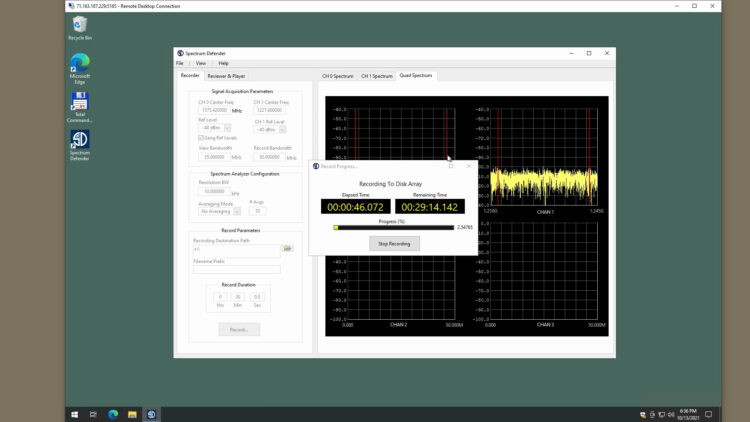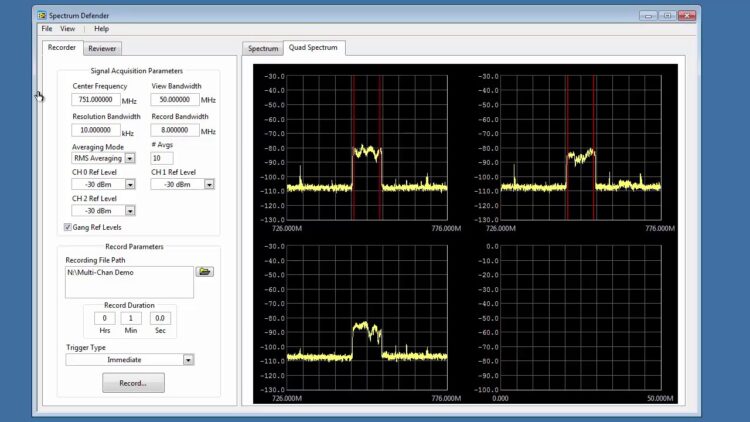Video Transcript:
Hello. My name is Sean Wallace. Welcome to this video.
Today I’d like to show you a overview of our basic RF record and playback software.
You’re looking here at version two point six of our single channel RF record play user interface And this software is currently running on National Instruments Vector Signal Analyzer and Vector Signal Generator hardware.
I have connected the vector signal analyzer to an off air television antenna so that we can actually record some signals off air. And I know that here in the Washington DC area, we have a television signal at five hundred and sixty nine megahertz, so I’m gonna go ahead and tune that center frequency in, and there it is. There’s the TV signal. It’s a little bit down in the mud there, so I’ll increase the sensitivity of the VSA hardware here by setting the reference level, maybe turn on some averaging so we can get a better look at the details over time, improve the resolution bandwidth, set it down to one kilohertz, and you can see that even with a one kilohertz resolution bandwidth across a twenty megahertz span, we still have a very, very fast update rate, which is quite uncommon in a traditional spectrum analyzer.
Okay. So there’s our TV signal. We can see that it’s a TV signal by that very distinctive pilot tone on the upper or the lower edge, I should say.
And an ideal TV signal, of course, would be flat. This one is not flat. It has a few notches, and that’s because there’s multipath applied. So this is a an interesting television signal, and it’s probably quite challenging to decode without errors.
So I think that’s an interesting candidate for recording.
The cord bandwidth is currently set to five megahertz. Most TV signals in the US certainly are six megahertz. But I’m gonna go ahead and record ten megs, and you can see those red cursors just tracked my new record bandwidth to ten megahertz.
Okay.
I’m going to leave the destination alone. It’s going to record to e, which is a high speed RAID. You do need a high speed disk system when you’re recording RF signals and we do configure all of our recording systems to have a high speed rate. Let’s record for about fifteen seconds.
I’m gonna leave the trigger type to immediate. I’m not gonna wait for an external pulse. I’m not gonna do anything fancy with the pre trigger. As soon as I hit record, data will start streaming.
And here we go. So right now, that RF signal is being down converted from RF to an IF to a baseband IQ data stream, and that high speed IQ data stream is getting recorded to our array of high speed disks.
Alright. The recording is complete. We revert back into the spectrum analyzer mode automatically, but let’s go ahead and look at that recording we just made. Come over here.
Each time we do a recording, the file name is assigned to the current date and time. So this is the one that we just did here. So you can clearly see the DTV signal over here. You can certainly see that pilot tone on the lower edge. And as I grab this slider bar here and scroll through time, you can see that I can scroll through the entire fifteen second recording and watch that DTV signal as it changes in time and watch for other interfering signals to pop up. Now, of course, this was fifteen seconds, but it could have been twenty four hours.
So we support a very wide variety of different recording, durations.
Okay. So that looks like an interesting signal. I I think it probably would be a little challenging for a real world television to decode that. So let’s try it out. I’ve connected a TV, digital TV to the SMA output port of the National Instruments Vector Signal Generator, and as soon as I hit play down here, this RF data stream or RF stream will play to through the RF vector signal generator into the television, and we will find out if the TV can decode that multipath impaired signal.
Okay. So there it goes. Everybody.
Hey. I got you. And it is decoding the video stream with no errors. So this, TV passes this little receiver performance test.
And that’s the basics for RF record and playback operations. Of course, we do have lots of other varieties including multi channel configurations, spectrum monitoring configurations, but here you’ve seen the basic RF record, review, and playback features in our standard package.

